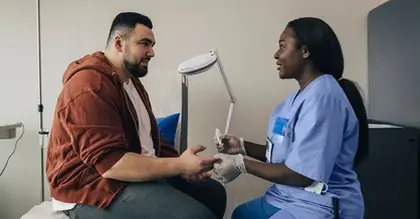
- There is currently no cure for Parkinson’s disease, nor are there specific tests for early diagnosis.
- A new study has identified a way to detect the condition before symptoms appear through the use of skin swabs via sebum and smell.
- The swabs could offer a noninvasive way to help diagnose Parkinson’s disease in people who have not yet developed symptoms.
According to the Parkinson’s Foundation, more than 10 million people around the world are living with Parkinson’s disease — a neurological disease that negatively impacts a person’s movement and speech abilities.
There is currently no cure for Parkinson’s disease. Although right now there are no specific tests to help diagnose the condition, identifying warning signs of Parkinson’s disease as early as possible is critical in helping to slow disease progression.
“Current clinical diagnosis is too late as disease has progressed a lot,” Drupad K. Trivedi, PhD, lecturer in analytical and measurement science at the University of Manchester, told Medical News Today.
Trivedi is the corresponding author of a new study recently published in the journal
For this study, scientists focused on testing study participants by using skin swabs of their sebum — an oily substance naturally produced by the skin’s
Through the skin swabs, Trivedi said they were able to detect volatile organic compounds (VOCs) in the sebum. Different VOCs have a distinct smell, which is what helps make each person’s body odor unique.
“We have found a few compounds that are expressed differently in people with Parkinson’s disease compared to Healthy controls as well as those who had REM sleep behavior disorder. A test that is a simple skin swab can potentially be the first test to detect Parkinson’s before all the clinical signs start appearing.”
— Drupad K. Trivedi, PhD
This study is an extension of two previous studies conducted by Trivedi and his team. The first study in March 2019 identified the presence of VOC biomarkers in the sebum of people with Parkinson’s disease that also has a distinct smell.
A second study in February 2021 that found a differential VOC profile between participants with Parkinson’s disease and controls when analyzing their sebum.
All of this research was reportedly inspired by Joy Milne, a research associate at the University of Manchester, who has a condition called hyperosmia, giving her an extremely strong sense of smell. In 2015, it was reported that Milne was able to “smell” Parkinson’s disease on her husband about six years before he received his diagnosis.
The concept of “smelling” Parkinson’s disease was further validated in a study recently published in the Journal of Parkinson’s Disease — for which Trivedi was also part of the research team — that found trained dogs could detect an odor on skin swabs to detect Parkinson’s disease.
Researchers recruited 83 study participants. Of this number, 46 had a Parkinson’s disease diagnosis, 28 were healthy controls, and nine had isolated REM Sleep Behavior Disorder (iRBD), which is considered to be an early warning sign of Parkinson’s disease.
Upon analysis, Trivedi and his team found that 55 significant features in the sebum that varied between the groups, and those with iRBD had levels in between those with Parkinson’s disease and the healthy controls.
“There were 55 features that showed levels for iRBD between healthy and Parkinson’s disease,” Trivedi detailed. “iRBD is one of the prodromal symptoms of Parkinson’s disease. This means a good proportion of individuals suffering from iRBD may develop Parkinson’s disease in the next decade or more. The intermediate level indicates a progression from control to iRDB to Parkinson’s disease.”
“By early detection, we will be able to triage and offer advanced clinical tests, specialist support for confirmatory diagnosis without relying on physical symptoms to appear,” he continued. “It also creates a potential to develop disease-modifying therapies in the future.”
“Next steps are to quantify these observed compounds in Parkinson’s disease and iRBD, and also validate these findings in a long-term prospective study of [a] bigger iRBD cohort,” Trivedi added.
Additionally, Trivedi collected sebum samples from people with Parkinson’s disease over a three-year period. From these samples, he was able to find sebum compound patterns that suggest this method may also be used to map disease progression.
“This indicates that molecules we see on (the) skin surface may indicate progression of Parkinson’s disease — it is a progressive disease with no cure,” he explained. “A sudden, rapid progression could be monitored in future using such markers on [the] skin surface. There is also a potential to monitor [the] efficacy of treatment by such an approach.”
MNT also spoke with Rocco DiPaola, MD, a neurologist and movement disorder specialist at Hackensack Meridian Neuroscience Institute at Jersey Shore University Medical Center in New Jersey, about this study.
DiPaola commented that this study’s results would offer a noninvasive tool for potentially diagnosing presymptomatic Parkinson’s disease.
“While there are currently no treatments that prevent or slow the progression of disease, as these treatments become available, it will be important to identify those at risk prior to symptom onset,” he continued. “Further studies on a larger scale to further determine validity of results as well as a means to have this available as a standardized test. Although not specific to this study, it would be important to continue to find ways to diagnose Parkinson’s disease prior to symptom onset.”





